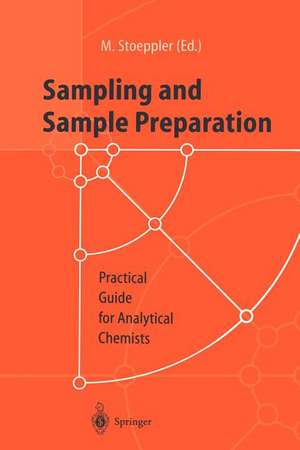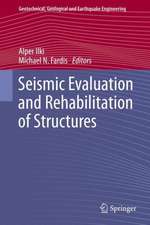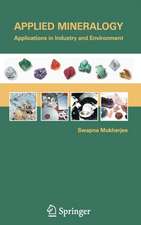Sampling and Sample Preparation: Practical Guide for Analytical Chemists
Editat de Markus Stoeppleren Limba Engleză Paperback – 18 sep 2011
Preț: 636.63 lei
Preț vechi: 748.97 lei
-15% Nou
Puncte Express: 955
Preț estimativ în valută:
121.86€ • 132.41$ • 102.43£
121.86€ • 132.41$ • 102.43£
Carte tipărită la comandă
Livrare economică 21 aprilie-05 mai
Preluare comenzi: 021 569.72.76
Specificații
ISBN-13: 9783642644863
ISBN-10: 3642644864
Pagini: 220
Ilustrații: XIV, 202 p.
Dimensiuni: 155 x 235 x 12 mm
Greutate: 0.31 kg
Ediția:Softcover reprint of the original 1st ed. 1997
Editura: Springer Berlin, Heidelberg
Colecția Springer
Locul publicării:Berlin, Heidelberg, Germany
ISBN-10: 3642644864
Pagini: 220
Ilustrații: XIV, 202 p.
Dimensiuni: 155 x 235 x 12 mm
Greutate: 0.31 kg
Ediția:Softcover reprint of the original 1st ed. 1997
Editura: Springer Berlin, Heidelberg
Colecția Springer
Locul publicării:Berlin, Heidelberg, Germany
Public țintă
ResearchCuprins
1 Sampling:an Introduction.- 1.1 General Remarks.- 1.2 Error Sources Prior to Total Element Determination.- 1.3 Sampling for Subsequent Determination of Chemical Species.- 1.4 Studies to Evaluate Sampling Errors.- 1.5 References.- 2 Human Specimens.- 2.1 Introduction.- 2.2 Human Specimens.- 2.3 Characterization.- 2.4 Sampling Procedures.- 2.5 References.- 3 Wet Precipitation:Rain and Snow.- 3.1 Introduction.- 3.2 Sampling Strategy.- 3.3 Sampling Equipment.- 3.4 Sampling in Winter.- 3.5 Sample Storage.- 3.6 Sample Preparation.- 3.7 Analytical Procedures.- 3.8 Results and Discussion.- 3.9 Conclusions.- 3.10 References.- 4 Sampling of Sea- and Fresh Water for the Analysis of Trace Elements.- 4.1 Introduction.- 4.2 Sample Handling.- 4.3 Sampling Procedures.- 4.4 Digestion.- 4.5 Typical Concentration Levels of Selected Trace Elements in the Aquatic Environment and Suitable Analytical Methods.- 4.6 Quality Assurance During Analysis and Data Evaluation.- 4.7 References.- 5 Soils and Soil Solutions.- 5.1 Introduction.- 5.2 Materials.- 5.3 Aspects of Soil Sampling and Recommendations for Its Realization….- 5.4 Sample Storage.- 5.5 Quality Control.- 5.6 Safety Precautions.- 5.7 References.- 6 Waste.- 6.1 Introduction.- 6.2 Theoretical Considerations for Sampling.- 6.3 Sampling and Storage.- 6.4 Decomposition and Analysis.- 6.5 Legal Requirements, Standards and Instruction Leaflets.- 6.6 Specific Problems.- 6.7 References.- 7 Collection, Preparation and Long-Term Storage of Marine Samples.- 7.1 Introduction.- 7.2 Tasks of the Environmental Specimen Bank.- 7.3 Collection.- 7.4 Sample Preparation.- 7.5 Conclusions.- 7.6 References.- 8 Biological Samples.- 8.1 Introduction: Ecological Basis – Information Content, Function and Indicative Value of Biological Specimens.- 8.2 QualityAssurance in Biological Sampling.- 8.3 Development of Specified Sampling Plans.- 8.4 Specific Problems of Sampling and Preparation of Biological Environmental Specimens.- 8.5 References.- 9 Sampling of Industrial Material (Sampling for the Balancing of Elements in the Cement Industry).- 9.1 Introduction.- 9.2 The Cement Clinker Burning Process.- 9.3 Sampling.- 9.4 Sample Preparation, Decomposition and Analysis.- 9.5 Checking Mass Flows.- 9.6 Conclusions.- 9.7 References.- 10 Food Products of Animal and Plant Origin.- 10.1 Introduction.- 10.2 Recommendations, Standards and Estimations of the Tolerable Intake of Toxic Metals via Food.- 10.3 Sample Collection.- 10.4 Sample Preparation.- 10.5 Homogenization.- 10.6 Decomposition Procedures.- 10.7 Analysis and Quality Control.- 10.8 Consumption Recommendations.- 10.9 References.- 11 Sample Preparation:an Introduction.- 11.1 General Remarks.- 11.2 Error Sources.- 11.3 Decomposition Directly Prior to Determination in Analytical Systems.- 11.4 Quality Assurance.- 11.5 References.- 12 Pressure Digestion: Apparatus, Problems and Applications.- 12.1 Introduction.- 12.2 Liner.- 12.3 Body.- 12.4 Safety Devices.- 12.5 Heating System.- 12.6 Conditions for Digestion.- 12.7 Completeness of Sample Decomposition.- 12.8 References.- 13 Microwave-Assisted Decomposition.- 13.1 Introduction.- 13.2 Microwave-Assisted Decomposition Apparatus.- 13.3 Comparison of Different Microwave-Assisted Digestion Systems.- 13.4 Criteria for the Evaluation of Microwave Digestion Systems.- 13.5 Conclusions.- 13.6 References.- 14 Decomposition Methods for the Electrochemical Determination of Elements.- 14.1 Introduction.- 14.2 Determination without Sample Decomposition.- 14.3 Oxidative UV-Digestion !..- 14.4 Mineralization by Oxygen.- 14.5 Open Wet Digestion.-14.6 Pressurized Digestion.- 14.7 Conclusions.- 14.8 References.- 15 Decomposition of Materials for Trace Analysis in the Cement Industry.- 15.1 Introduction.- 15.2 Decomposition Methods.- 15.3 Examples.- 15.4 References.
Textul de pe ultima copertă
This book describes in great detail sampling and sample preparation in routine and research. All chapters are written for practitioners by experts in the field. The book provides well-documented and illustrated procedures for sampling and sample preparation prior to trace metal analysis. A careful selection of appropriate references to pitfalls, methods and strategies furnishes the information for a proper performance of the most crucial steps of any analytical procedure.












